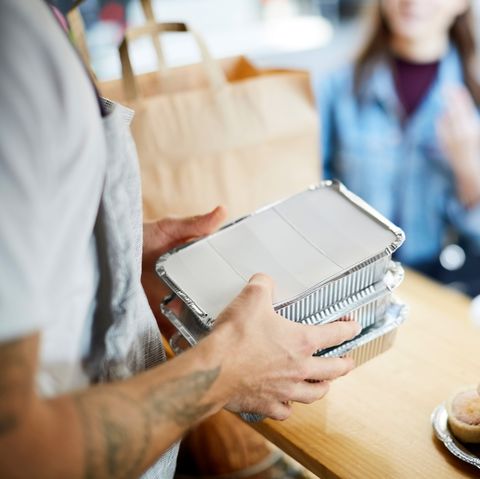Sandra Hassine, M.D., has been studying childhood obesity for more than 30 years. And the most important thing she’s learned— applicable to kids and grown men alike—is this: “All the willpower in the world,” she says, “can’t overcome an obesogenic environment.”
In other words, to lose weight and keep it off, you have to adjust your world so it’s not constantly tempting you. Instead of putting yourself on a diet, put your environment on one.
“You can’t make good health decisions if your environment is always working against you, because then you have to be on alert 24-7,” says Dr. Hassink, founder of the Nemours Weight Management Clinic in Wilmington, Delaware. “You get tired. Things come up. It’s hard to [be successful] without creating a healthy environment in the first place.”
With the help of Dr. Hassink and other weight management experts, let’s start fat-proofing your world.
1. Do a Sunday evening junk-food dump.
Like lint on a black sweater, unhealthy foods and snacks can accumulate in your home without your realizing it.
Pie from the church bake sale, caramel popcorn from the Boy Scouts, a pork-kraut roll from Mom. And before you know it, you’re shoveling it into your mouth. Start the workweek fresh by taking a few minutes to rid your kitchen of crap and shake the airline stroopwafels out of your briefcase.

Getty Images
“It’s amazing how much food can creep in,” Dr. Hassink says. If you don’t have the heart to toss Mom’s signature dish, just divide it into smaller portions to freeze and reheat later. And don’t get doggie bags at restaurants anymore—unless they’re actually for your dog.
2. Trim down your social media “feed.”
As if Mark Zuckerberg doesn’t have enough reason to feel guilty, Facebook could also be insidiously filling you out. If certain friends and family members are constantly sharing food porn and decadent recipes, their posts could be fattening up your space.
“How much time are you spending on those posts? Take notice if you find yourself getting hungry just looking at them,” Dr. Hassink says.
If you are, then hide, snooze, or unfollow the worst offenders. Likewise, trade all those craft breweries and barbecue joints you follow for sites that deliver positive reinforcement, such as @mealprepdaily, @wickedhealthy, @besmarteatsmart, and Men’s Health’s very own @guygourmet.
3. Tweak your grocery list.
A common belief is that eating healthy costs a lot. Not true, says Adam Drewnowski, Ph.D., director of the University of Washington Center for Public Health Nutrition.

Getty Images
Research shows that the healthiest diets—ones rich in fruits, vegetables, fish, and nuts—cost only $1.56 more per day (that’s $10.92 per week) than the least healthy diets—processed foods and meats, refined grains.
In fact, stocking your world with nutritious choices needn’t cost anything extra. Swap the ten bucks you’re currently dropping on cold cuts, bread, and chips for a pound of fresh strawberries ($3.99), an avocado ($1.50), a bag of romaine ($2.60), and two single-serving containers of Greek yogurt ($1 each).
Drewnowski calls this an “economic intervention,” a conscious spending of $1.56 a day on healthy foods instead of fattening, carb-filled ones that will pay off with gradual weight loss.
4. Declare war on one junk food each month.
Diets fail because guys make too many changes too suddenly and try to do it all on their own. So try getting everyone in the family to agree on voting one junk food out of the house each month.
Eliminating sugary drinks is an obvious place to start. “Sugar-sweetened beverages add a lot of unnecessary calories to our lives, and they are not nutritious,” says Dr. Hassink.
If anyone balks at the idea, suggest tapering consumption week by week. Then next month, after you’ve lost your taste for sweetened beverages (and you will), boycott another unhealthy food. The support of other people makes it easier.
5. When traveling, book a room in a pedestrian-friendly part of town.
Whether you’re on the road for business or vacation, you’ll get more exercise and burn more calories if you skip the car rental and stay in a hotel or Airbnb in the center of town, where you can safely walk everywhere.

Getty Images
“Nutrition and activity are not just sideline things we do, but health-building or health-losing activities,” Dr. Hassink explains. “Every decision you make about eating and activity is a health decision.”
6. Call the hotel help desk.
Request that the mini-fridge in your hotel room be emptied before check-in. This removes any possibility that you’ll give into temptation and wake up in a bed full of Toblerone wrappers and tiny liquor bottles. Pack (or shop for) your own healthy snacks instead and pop them in the fridge.
7. Renting a car? Go compact.
When you step up to the reservations counter, ask the rep if you can be downgraded. That’s right. A bigger rental may increase your risk of supersizing your meals and drinks on the road. It’s simply more comfortable and convenient. Think about it: If the cupholders can easily accommodate a Big Gulp, so can you.
8. Never let your fridge become empty.
It sounds counterintuitive for weight loss, but the moment this happens is the moment you become more likely to go out and order the Mini Corn Dog party platter at Buffalo Wild Wings. So keep that refrigerator at least looking full, says Judy Simon, R.D.N., of UW Medicine in Seattle.
Buy enough fruit, vegetables, and lean meats to last for the week, shop twice a week, or set up regular delivery with your local supermarket. Or simply pull your food to the front of the shelves to create an illusion of plenty.
9. Change your commute.
If you often succumb to temptation and stop for, say, a Grande Caffè Mocha at Starbucks on your way to work, consider changing your route. That drink, even when made with 2% milk, has 360 calories, 15 grams of fat, 44 grams of carbs, and 35 grams of sugar.

Getty Images
Add a blueberry muffin and you’ve just turned breakfast into a gut bomb. Keeping your kryptonite out of sight will make it less convenient to pull in and indulge there.
10. Make sure you’re safe at this dangerous time.
Specifically, the hour or two after work ends and before dinner begins is a weak spot for many men, says Simon. Make sure you’re nowhere near a happy hour with free appetizers or an ice cream stand with a drive-thru during these times. Stash your favorite protein bar in your car in case of emergency.
11. Parental-control yourself.
Don’t spend your weekends or evenings watching the Food Network or sports programming with lots of food and beverage advertising.

Getty Images
When the food shows and ads are streaming, the temptation to overeat tends to increase, says Dr. Hassink. Try watching something less food-centric (or leaving the room during commercials) and see if your cravings don’t subside.
12. Find a “safety” restaurant.
Every meal can’t be home-cooked. Occasionally life’s challenges will force you to eat out or order takeout. But don’t let that decision be impromptu. Instead, do your homework ahead of time and pick a “safety” restaurant or two near home with some nutritious choices (or at least a cook willing to broil instead of fry and who knows what “light cheese” really means).
Think of this spot like your grandparents viewed their local diner, but healthier. Researching tip: Eliminate any place with the word “loaded” on its menu.
13. Manage the candy stash.
To keep from filching Easter baskets or Halloween treats, buy candy just one day before the holiday. Buy only as much as needed, and then immediately get rid of leftovers. The less time sweets linger in the house, the less likely you’ll be to eat them.
And above all, never volunteer to be the dad who loans his garage to the Girl Scout troop for cookie storage.
Source: Read Full Article
